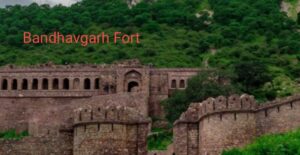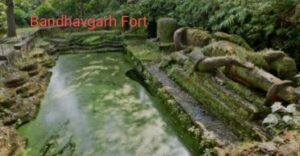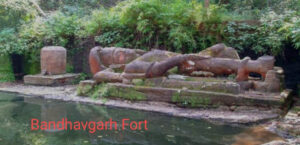Located deep within the jungles of Madhya Pradesh, Bandhavgarh Fort stands as a historical and architectural marvel. Nestled in the heart of Bandhavgarh National Park, this ancient fort is not only a testament to India’s rich history but also a reminder of its connection to nature and wildlife. The fort, which rises majestically atop a hill, holds a significant place in the history of the region, boasting stories of mythological origins, ancient rulers, and centuries-old temples.
In this post, we’ll take you on a journey through the history, architecture, and cultural significance of Bandhavgarh Fort, along with tips on how to explore it and its surrounding natural beauty.

1.The Historical Significance of Bandhavgarh Fort
Bandhavgarh Fort is not just a historical monument; it is deeply woven into India’s mythological and historical tapestry. Its origins are steeped in legend, with the most popular myth linking it to the Ramayana. According to Hindu mythology, Lord Rama is said to have gifted the fort to his brother Lakshmana after their victory over Ravana. The name “Bandhavgarh” itself means “Brother’s Fort” in Sanskrit, paying homage to this ancient tale.
In addition to its mythological connections, the fort has seen many rulers over the centuries, with the Baghel dynasty playing a significant role in its history. The Baghel kings ruled the area for centuries and used the fort as a military stronghold, helping them maintain control over the region. The fort was a hub of political and military activity, shaping the region’s history for generations. Although it now lies in ruins, the fort’s walls still echo with the stories of battles fought and lives lived within its majestic confines.
2.Architecture and Structure of Bandhavgarh Fort
Bandhavgarh Fort is a fine example of ancient Indian architecture, blending military defense with religious and cultural elements. The fort sits at an elevation of 811 meters (2,660 feet), perched on a hill that provides panoramic views of the surrounding forests and valleys. This strategic location allowed the fort to serve as a key defensive structure, safeguarding the region from invaders.
The fort’s design includes strong stone walls, large gateways, and intricate carvings that reflect the architectural prowess of its builders. Within its grounds, you’ll find the remains of several temples, built over different periods. The most notable of these is the large statue of Lord Vishnu, reclining on a seven-headed serpent, dating back to the 10th century. This iconic sculpture, known as Shesh Shaiya, is one of the key attractions within the fort.
Though much of the fort is now in ruins, the remnants of its grandeur can still be seen in its temples, walls, and courtyards, offering a glimpse into the past.

3.Bandhavgarh Fort and Bandhavgarh National Park
One of the most unique aspects of Bandhavgarh Fort is its close connection to Bandhavgarh National Park. The fort is located within the park, which is famous for its dense forests and high population of Bengal tigers. In fact, Bandhavgarh National Park is known for having one of the highest tiger densities in the world, making it a prime destination for wildlife enthusiasts.
From the fort’s high vantage point, visitors can often spot wildlife roaming the vast wilderness below. Tigers, leopards, deer, and various species of birds can all be seen from the fort, making it an excellent location for wildlife photography and nature lovers. The juxtaposition of ancient human history with the thriving natural ecosystem around it makes a visit to Bandhavgarh Fort a truly unique experience.
Whether you’re a history buff or a nature enthusiast, the fort offers a perfect blend of both worlds.

4.Cultural and Religious Significance
Bandhavgarh Fort is not just a historical and military stronghold; it is also a site of immense cultural and religious significance. Scattered throughout the fort are several ancient temples, each of which holds spiritual importance for local communities and pilgrims. The most notable among these is the Vishnu Temple, home to the massive statue of Lord Vishnu reclining on the Sheshnag (serpent).
Many pilgrims make the journey to Bandhavgarh Fort to pay their respects at these temples, particularly during festivals like Ram Navami. The fort has long been considered a spiritual site, attracting visitors not just for its historical importance, but also for its religious significance.
The combination of history, spirituality, and myth makes Bandhavgarh Fort a place where the past and the present intersect, offering visitors a chance to reflect on both.
5.Tourism at Bandhavgarh Fort
Bandhavgarh Fort is a must-visit destination for history lovers, nature enthusiasts, and spiritual seekers alike. Its location within Bandhavgarh National Park makes it accessible for those already visiting the park for wildlife safaris. However, exploring the fort itself requires a separate visit due to its elevation and size.
To reach Bandhavgarh Fort, visitors typically start from the nearby town of Tala, which serves as the gateway to both the national park and the fort. It is best to visit during the cooler months, between October and March, when the weather is more favorable for exploring both the fort and the park.
Tour guides are available to provide insight into the fort’s history and architecture, and many tour operators offer packages that combine a visit to the fort with a wildlife safari in Bandhavgarh National Park. Accommodations range from eco-friendly resorts to budget lodges, ensuring that visitors have comfortable options no matter their travel style.
6.Conservation Efforts and Challenges
Despite its historical significance, Bandhavgarh Fort faces several challenges in terms of preservation. Over the centuries, natural erosion and human activity have taken their toll on the fort’s structure. Conservation efforts have been underway to restore and protect parts of the fort, especially its temples and walls, but these efforts are often hindered by funding issues and the complex terrain.
Moreover, the fort’s location within a wildlife reserve presents additional challenges. While the presence of wildlife adds to the fort’s allure, it also means that conservation efforts must strike a balance between preserving the fort and protecting the surrounding ecosystem.
Local authorities and organizations continue to work on preserving the fort while ensuring that tourism does not negatively impact the national park’s wildlife.
Conclusion:
Bandhavgarh Fort stands as a lasting symbol of India’s rich history, mythology, and culture. It offers visitors a unique opportunity to explore an ancient fort while also enjoying the natural beauty of one of India’s most famous wildlife reserves. Whether you are drawn to its historical roots, its architectural marvels, or its proximity to nature, Bandhavgarh Fort is a destination that should not be missed.
With ongoing conservation efforts and increasing interest from tourists, Bandhavgarh Fort will continue to captivate and inspire visitors for generations to come. Have you visited this magnificent site? Share your experience in the comments below!
FAQ:
1.Who built Fort of Bandhavgarh?
2.What is the story of Bandhavgarh Fort?
3.What is Bandhavgarh famous for?
4.How old is Bandhavgarh Fort?
5.Bandhavgarh fort wikipedia
6.Bandhavgarh Fort visit
7.How to reach Bandhavgarh Fort
8.Bandhavgarh Resort
9.Bandhavgarh temple
10.History of Bandhavgarh National Park

